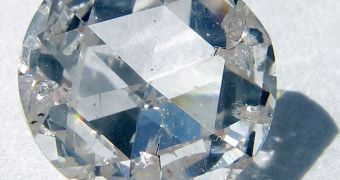Standard plate tectonics theory holds that the planetary crust gets submerged at subduction zones. It then gets decomposed and recycled, with new crust forming in specialized areas called ridges. A new study has now determined that the recycling can occur in the lower mantle as well.
Our planet is divided into three main layers – the crust, the mantle and the core. There are two main types of crust, oceanic and continental, an upper and lower mantle, as well as an inner and outer core. The outer core connects to the lower mantle, while the upper mantle connects to the crust.
According to theory, when two tectonic plates collide, portions of crust slid underneath one another, entering the upper mantle. Until now, it was believed that the recycling process occurred exclusively at this level. The new study proves things are in fact different.
By analyzing the isotopic composition of materials inside diamonds, a team led by experts at the University of Bristol was able to determine that rocks from the Earth's surface can travel as deep as the lower mantle, some 660 to 2891 kilometers underground.
After the crust is broken down in its components, it is replaced at the surface through divergent tectonic plate boundaries called ridges. From these structures, lava pours out inside oceans or on land, causing tectonic plates to push apart from each other. The mid-Atlantic ridge is a prime example of this.
Bristol experts professor Michael Walter, Dr. Simon Kohn, Dr. Galina Bulanova and Christopher Smith worked together with colleagues at the Universidade de Brasilia, in Brazil, and the Carnegie Institution of Washington (CIW), in the United States, for this investigation.
Details of the research were published in this week's issue of the top journal Science. The diamonds used in this investigation were extracted from the Juina region of Brazil. The western shores of South America are part of the massive subduction zone called the Pacific Ring of Fire.
“Inclusions in diamonds are fantastically useful for studying the inaccessible part of the deep Earth. It’s a bit like studying extinct insects in amber,” Walter explains. He and his team analyzed mineral inclusions that remained trapped in these diamonds for millions of years.
“Although we can’t extract DNA and grow dinosaurs, we can extract their chemical compositions and tell where they formed by growing minerals in the lab at extreme conditions,” the expert goes on to say.
“The amazing thing about the diamonds from Juina is that each new batch we study provides something unexpected. As we investigate them in more detail with new techniques they continue to give up more of their remarkable secrets,” Kohn concludes.

 14 DAY TRIAL //
14 DAY TRIAL //